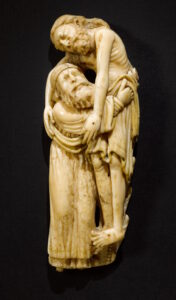 The National Museum of Ireland received two Early Bronze Age axes in the mail last month from an anonymous sender. They are flat axeheads dating to around 2150-2000 B.C. and are highly significant artifacts from Ireland’s prehistory. The museum is asking the public for any information they might have about the location and circumstances of the axes’ discovery.
The National Museum of Ireland received two Early Bronze Age axes in the mail last month from an anonymous sender. They are flat axeheads dating to around 2150-2000 B.C. and are highly significant artifacts from Ireland’s prehistory. The museum is asking the public for any information they might have about the location and circumstances of the axes’ discovery.
The donor sent the axeheads carefully packed in styrofoam with custom cut-outs inside a box of Flahavan’s Irish Oaty Flapjacks (which are crunchy granola bar-like squares, not flapjacks in the American sense of pancakes). A letter was included but it was scant on detail, saying only that the axeheads had been discovered in the Westmeath area using a metal detector.
However, to fully understand and appreciate these artifacts, it’s crucial to know the exact location where they were found. The context of such discoveries helps archaeologists piece together ancient settlement patterns and cultural practices. For instance, hoards or collections of objects were often deliberately placed in specific locations for reasons that could range from ritualistic to supernatural.
With this in mind, we are appealing to the person who sent these axeheads to reach out to us. Any information about their discovery will be treated with the utmost confidentiality and used solely to verify the find location and its circumstances.
The National Museum of Ireland is currently participating in an international study of Bronze Age metalwork, aiming to trace the origins of the metals used in such artifacts. Details about the find spot of these axeheads could provide critical data for this research.
By Irish law, archaeological finds must be reported to the authorities, which was obviously not done in this case, and explains why the sender is keeping mum.
We also wish to remind everyone about the regulations surrounding the use of metal detectors for searching archaeological objects. Archaeological finds without a known owner are the property of the state and are preserved as part of our collective heritage in national and designated museums.
The museum isn’t the law, however, and they have no interest in pursuing the finder. They just want information, which can sent to their email address or phoned in at 01-6777444. (Cool number. It’s like a fake one from a movie.)











